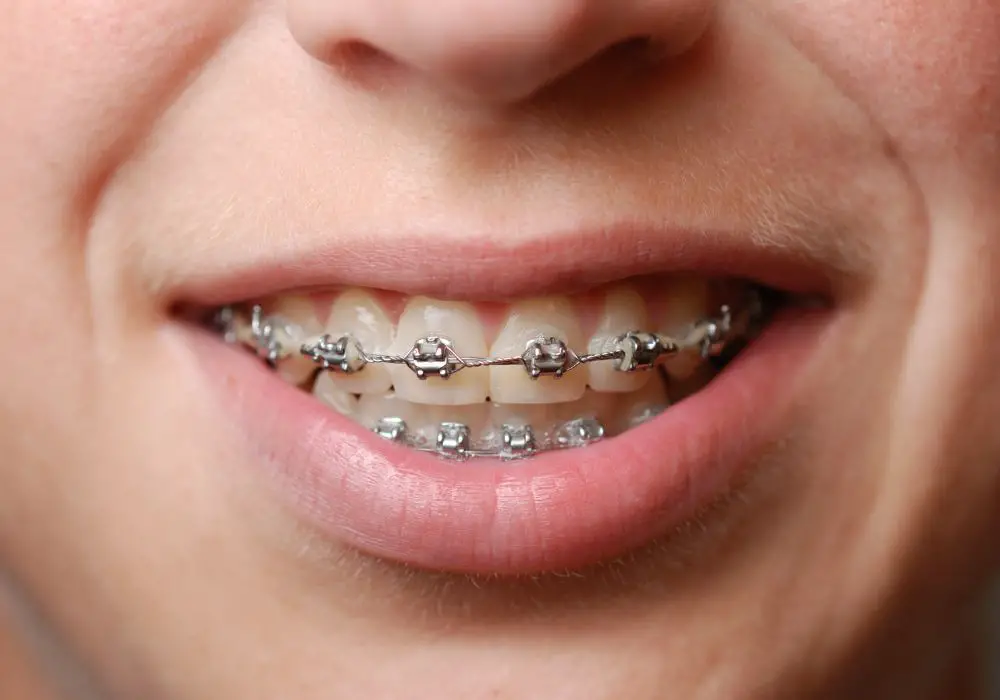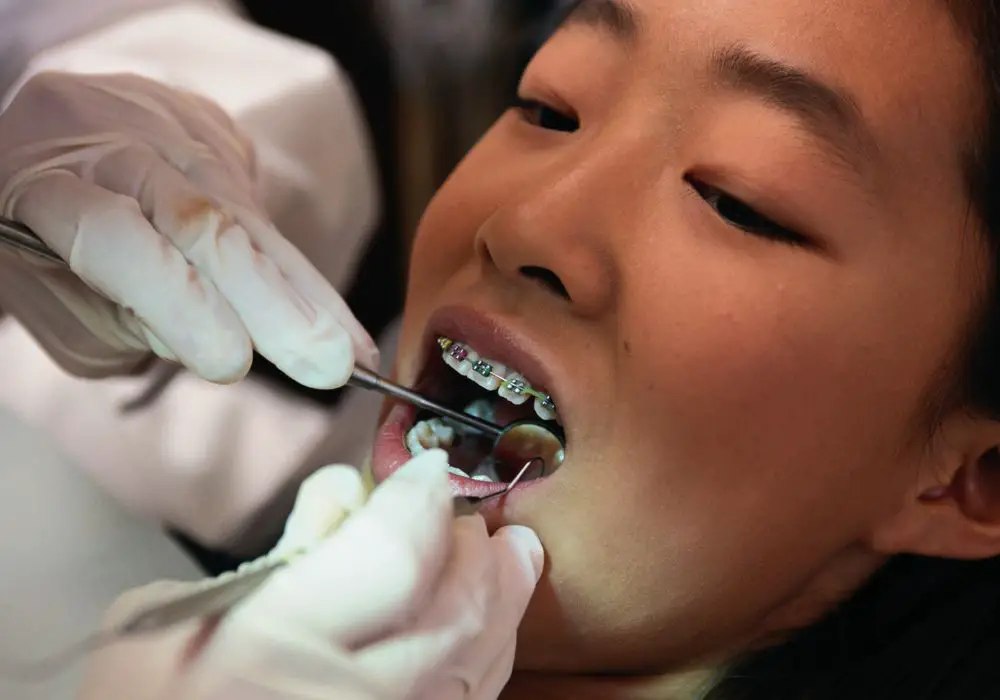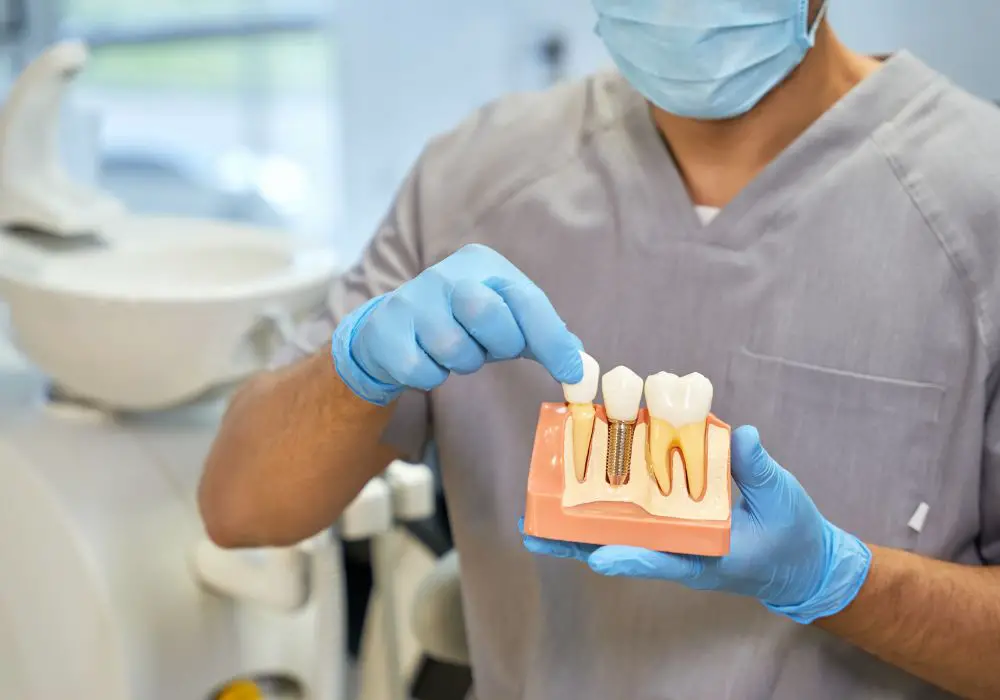If you have missing teeth, you may be wondering if you can still get braces. The answer is yes, but it depends on how many teeth are missing and the overall health of your mouth. Specifically, if you are missing four teeth, you may still be able to get braces, but your orthodontist will need to evaluate your situation to determine the best course of action.
When you have missing teeth, the remaining teeth can shift and move around, causing problems with your bite and alignment. Braces can help correct these issues, but it’s important to have a plan in place to address the missing teeth. Your orthodontist may recommend using braces to close the gaps where the teeth are missing or using other methods, such as dental implants or bridges, to replace the missing teeth before or during your orthodontic treatment. It’s important to discuss all of your options with your orthodontist to determine the best approach for your specific situation.
Understanding Dental Braces

Dental braces are a common orthodontic treatment that can help straighten your teeth, close gaps, and improve your overall oral health. If you have missing teeth, you may be wondering if you can still get braces. The good news is that in most cases, you can.
Braces work by applying pressure to your teeth over time, gradually shifting them into the desired position. They consist of brackets that are attached to your teeth and wires that are threaded through the brackets. The wires are then tightened periodically to adjust the pressure and move your teeth.
When you have missing teeth, your orthodontist will take this into account when designing your treatment plan. They may need to close gaps between your teeth or create space for replacement teeth if you plan on getting dental implants or other restorative treatments.
It’s important to note that getting braces with missing teeth may take longer than if you had a full set of teeth. Your orthodontist will need to carefully plan your treatment to ensure that your remaining teeth are moved into the correct position and that any gaps are closed properly.
Overall, if you have missing teeth and are considering braces, it’s important to talk to your orthodontist to see if this is a viable option for you. They can help you understand the process and what to expect during treatment.
The Impact of Missing Teeth on Dental Braces
Missing teeth can have a significant impact on the effectiveness of dental braces. When teeth are missing, it can cause the remaining teeth to shift, leading to bite irregularities and other oral health issues. This is why it’s important to address missing teeth before undergoing orthodontic treatment.
If you have four missing teeth, your orthodontist may recommend dental implants to replace them before starting braces treatment. Dental implants are artificial teeth that are surgically placed into the jawbone, providing a stable foundation for braces. Implants can also prevent the remaining teeth from shifting, ensuring that your braces treatment is effective.
Another option for replacing missing teeth is a dental bridge. A bridge is a prosthetic device that is anchored to the adjacent teeth, filling in the gaps left by missing teeth. However, bridges may not be as stable as implants and can cause additional strain on the remaining teeth.
In some cases, your orthodontist may recommend closing the spaces left by missing teeth with braces alone. However, this approach may not be as effective as using implants or bridges, and may take longer to achieve the desired results.
Overall, addressing missing teeth before undergoing braces treatment is crucial for achieving optimal oral health and a beautiful smile. Your orthodontist can help you determine the best course of action for replacing missing teeth and achieving your desired results with braces.
Types of Braces Suitable for Missing Teeth
If you have missing teeth and are considering getting braces, you may be wondering what types of braces are suitable for your situation. Here are some options to consider:
Traditional Metal Braces
Traditional metal braces are the most common type of braces and can be used to treat a variety of dental issues, including missing teeth. Metal braces use brackets and wires to gradually move your teeth into the correct position.
If you have missing teeth, your orthodontist may recommend using metal braces to close the gaps and realign your remaining teeth. In some cases, your orthodontist may also use additional appliances, such as springs or rubber bands, to help shift your teeth into the correct position.
Ceramic Braces
Ceramic braces are similar to metal braces, but the brackets are made of clear or tooth-colored materials that blend in with your teeth. This makes them a popular choice for people who want a more discreet option.
Ceramic braces can also be used to treat missing teeth. Your orthodontist may use ceramic braces to close gaps and realign your remaining teeth, just like with metal braces.
Lingual Braces
Lingual braces are similar to traditional metal braces, but the brackets and wires are attached to the back of your teeth instead of the front. This makes them virtually invisible from the front.
Lingual braces can be used to treat missing teeth, but they may not be the best option for everyone. They can be more difficult to clean and maintain than other types of braces, and they may also take longer to adjust to.
Invisalign
Invisalign is a popular alternative to traditional braces that uses clear, removable aligners to gradually shift your teeth into the correct position. Invisalign can be a good option for people with missing teeth, but it may not be suitable for everyone.
If you have missing teeth, your orthodontist may recommend using Invisalign to realign your remaining teeth and close any gaps. However, if you have multiple missing teeth or severe bite issues, Invisalign may not be the best option for you.
Overall, there are several types of braces that can be used to treat missing teeth. Your orthodontist can help you determine which option is best for your individual needs and goals.
Process of Getting Braces with Missing Teeth

If you have missing teeth, you may be wondering if you can still get braces to straighten your teeth. The answer is yes, in most cases, you can still get braces even if you have missing teeth. Here’s what you can expect when getting braces with missing teeth.
Consultation with an Orthodontist
The first step in getting braces with missing teeth is to schedule a consultation with an orthodontist. During this consultation, the orthodontist will examine your teeth and gums to determine if you are a good candidate for braces. They will also discuss your treatment options and answer any questions you may have.
Treatment Plan
Once you have decided to get braces, the orthodontist will create a treatment plan based on your specific needs. If you have missing teeth, the orthodontist may recommend closing the gaps with braces or leaving the gaps open and moving the remaining teeth into the correct position.
Braces Placement
The next step is to have your braces placed. If you have missing teeth, the orthodontist may need to place brackets and wires only on the teeth that are present. They may also use special techniques to move teeth into the correct position without putting too much pressure on the missing teeth.
Adjustments
After your braces are placed, you will need to visit the orthodontist regularly for adjustments. During these appointments, the orthodontist will tighten the wires and adjust the brackets to continue moving your teeth into the correct position.
Completion of Treatment
Once your treatment is complete, the orthodontist will remove your braces. If you have missing teeth, they may recommend additional treatment, such as dental implants or bridges, to replace the missing teeth and complete your smile.
In summary, getting braces with missing teeth is possible, and the process is similar to getting braces with a full set of teeth. With the help of an experienced orthodontist, you can achieve a straighter, healthier smile even if you have missing teeth.
Considerations Before Getting Braces
If you have missing teeth and are considering getting braces, there are a few things to keep in mind before making a decision.
Dental Health
Before getting braces, it’s important to make sure that your overall dental health is in good condition. If you have any existing dental issues, such as gum disease or tooth decay, these should be addressed before starting orthodontic treatment.
Number of Missing Teeth
The number of missing teeth you have will also be a factor in determining whether or not you are a good candidate for braces. If you have only one or two missing teeth, braces may still be an option. However, if you are missing several teeth, your orthodontist may recommend other dental appliances, such as bridges or implants, to help fill in the gaps.
Length of Treatment
If you have missing teeth, it may take longer to achieve the desired results with braces. Your orthodontist will need to carefully plan your treatment to ensure that your remaining teeth are properly aligned and that any gaps are closed.
Cost
The cost of braces can vary depending on a number of factors, including the type of braces you choose and the length of your treatment. If you have missing teeth, you may need to factor in the cost of additional dental appliances, such as bridges or implants, to help fill in the gaps.
Orthodontist Experience
When choosing an orthodontist, it’s important to choose one with experience in treating patients with missing teeth. They will be better equipped to develop a treatment plan that is tailored to your specific needs and will be able to address any concerns you may have.
Alternatives to Braces for Those with Missing Teeth

If you have missing teeth, you may be wondering if braces are still an option for you. The good news is that there are alternatives to braces that can help straighten your teeth even if you have missing teeth. Here are some options:
Dental Implants
Dental implants are a popular option for replacing missing teeth. They are a permanent solution that can last for decades. A dental implant is a small titanium post that is surgically placed into the jawbone. Once the implant has fused with the bone, a crown is attached to the top of the post. Dental implants look and function like natural teeth, making them a great option for those with missing teeth who want to straighten their teeth.
Fixed Bridges
A fixed bridge is another option for replacing missing teeth. A bridge is made up of two or more crowns that are attached to the teeth on either side of the gap. The crowns hold a false tooth in place, bridging the gap. Fixed bridges are a good option for those who have missing teeth in a row.
Removable Partial Dentures
If you have several missing teeth, a removable partial denture may be a good option for you. A partial denture is a removable appliance that has replacement teeth attached to a gum-colored plastic base. The denture is held in place by clasps that attach to the remaining teeth. Partial dentures can be removed for cleaning and are a good option for those who are missing several teeth in a row.
Clear Aligners
Clear aligners are a popular alternative to traditional braces. They are clear plastic trays that are custom-made to fit over your teeth. You wear each set of aligners for a few weeks before switching to the next set. Clear aligners can help straighten your teeth even if you have missing teeth. However, they may not be the best option if you have severe misalignment or bite issues.
In summary, there are several alternatives to braces for those with missing teeth. Dental implants, fixed bridges, removable partial dentures, and clear aligners are all options that can help straighten your teeth and improve your smile. Talk to your dentist or orthodontist to determine which option is best for you.
Maintaining Oral Health with Braces and Missing Teeth
If you have missing teeth and are considering braces, you may be wondering how to maintain your oral health during treatment. While missing teeth can present some challenges, there are steps you can take to ensure that your teeth and gums stay healthy while you straighten your smile.
First, it’s important to note that braces can be a great option for people missing teeth, as they can close or widen gaps to leave the perfect amount of space for a replacement. However, it’s essential to work closely with your orthodontist to develop a treatment plan that addresses your specific needs and concerns.
During treatment, you’ll need to be diligent about maintaining good oral hygiene habits. This includes brushing and flossing regularly, as well as using any additional tools or products recommended by your orthodontist. Keeping your teeth and gums clean and healthy will reduce the risk of developing gum disease or other oral health issues.
In addition to practicing good oral hygiene, there are other steps you can take to maintain your oral health while wearing braces with missing teeth. These may include:
- Eating a healthy, balanced diet that’s rich in vitamins and minerals to support strong teeth and gums.
- Avoiding hard, sticky, or chewy foods that can damage your braces or dislodge brackets or wires.
- Wearing a mouthguard during physical activity to protect your teeth and braces from damage.
- Scheduling regular checkups with your orthodontist to monitor your progress and address any concerns or issues that arise.
By taking these steps and working closely with your orthodontist, you can maintain good oral health while straightening your smile with braces and missing teeth. With a little extra care and attention, you can achieve the beautiful, healthy smile you’ve always wanted.
Cost and Insurance Considerations for Braces with Missing Teeth
If you have missing teeth and are considering getting braces, there are a few cost and insurance considerations to keep in mind. Here are some things to keep in mind:
Cost of Braces with Missing Teeth
The cost of braces with missing teeth can vary depending on a few factors, including the type of braces you choose, the severity of your case, and the number of missing teeth you have. On average, traditional metal braces cost between $2,500 and $7,500, while clear aligners like Invisalign can cost between $3,500 and $8,000.
If you have missing teeth, you may need additional treatments like dental implants or bridges to fill in the gaps before you can get braces. The cost of these treatments can vary depending on the number of missing teeth you have and the type of restoration you choose.
Insurance Coverage for Braces with Missing Teeth
Not all dental insurance plans cover orthodontic treatment, and even those that do may not cover treatment for missing teeth. If your dental insurance plan does cover braces, it may only cover a portion of the cost, leaving you with a significant out-of-pocket expense.
If you have medical insurance, it may cover the cost of dental implants or bridges if they are deemed medically necessary. However, coverage for orthodontic treatment can vary widely depending on your specific plan and the reason for your treatment.
Financing Options for Braces with Missing Teeth
If you don’t have insurance coverage for braces or need additional financing for dental implants or bridges, there are several financing options available. Many orthodontic offices offer payment plans or financing options through third-party lenders to help make treatment more affordable.
You may also be able to use a health savings account (HSA) or flexible spending account (FSA) to cover some of the cost of braces or dental implants. Check with your employer or insurance provider to see if these options are available to you.
In summary, getting braces with missing teeth can be a costly endeavor, but there are financing options available to make treatment more affordable. Be sure to check with your insurance provider to see what is covered and explore all of your financing options before starting treatment.
Frequently Asked Questions
Can you get braces with missing front teeth?
Yes, you can still get braces even if you have missing front teeth. However, depending on the severity of the gap, your orthodontist may recommend additional treatments such as dental implants or bridges to fill the gap before starting the braces treatment.
Braces with fake teeth attached cost?
The cost of braces with fake teeth attached can vary depending on the type of braces and the materials used for the fake teeth. It’s best to consult with your orthodontist to get an accurate estimate of the cost.
Can you get braces with tooth decay?
It is possible to get braces with tooth decay, but it’s important to address the decayed teeth before starting the treatment. Your orthodontist may recommend getting the decayed teeth treated by a dentist before starting the braces treatment.
Can you get braces with a crown?
Yes, you can still get braces with a crown. However, your orthodontist will need to take extra precautions to ensure that the braces don’t damage the crown. They may recommend using a protective cover or other measures to protect the crown during the treatment.
Can you get braces with partial dentures?
Yes, you can still get braces with partial dentures. However, your orthodontist may need to make adjustments to the dentures to ensure that they don’t interfere with the braces treatment.
Invisalign braces with missing teeth?
Yes, you can still get Invisalign braces even if you have missing teeth. However, depending on the severity of the gap, your orthodontist may recommend additional treatments such as dental implants or bridges to fill the gap before starting the Invisalign treatment.







